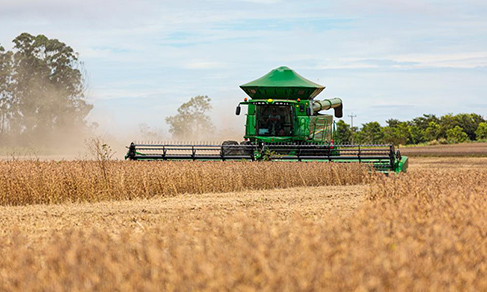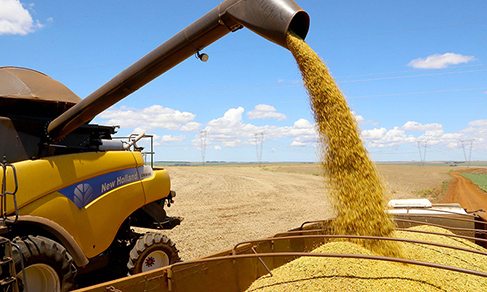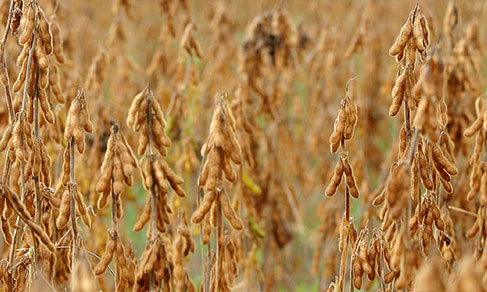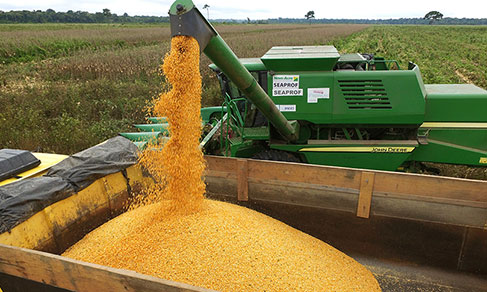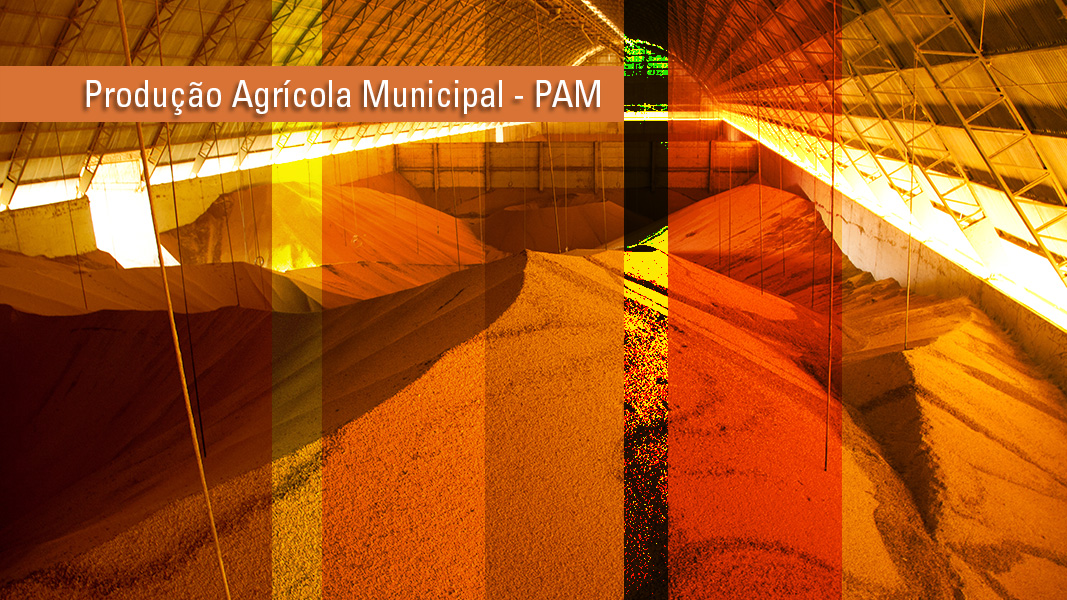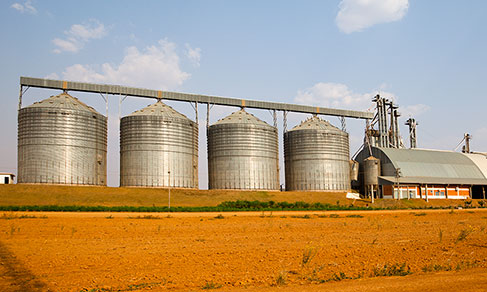Nossos serviços estão apresentando instabilidade no momento. Algumas informações podem não estar disponíveis.
PAM - Municipal Agricultural Production
About - 2022
The Municipal Livestock Production Survey investigates, annually, a set of products from temporary and permanent crops in Brazil that are characterized not only by their great economic importance to the export agenda, but also by their social relevance, being part of the Brazilian basic food basket.
In this fact sheet, the IBGE presents general commentaries on the main results of PAM relative to 2022, encompassing information on panted areas/area to be harvested, harvested area, amount produced, average yield and value of production of the products investigated by Major Regions, Federation Units and Municipalities. The analysis focuses on the performance of the most relevant crops, either in productive or commercial terms, from which stand out the spatial distribution of the main agricultural products over the in territory and their relative participation in value of production at regional and national level, the output obtained in the main producing municipalities, as well as the most influential factors to results and to the productivity of crops, among other aspects.
It is worth mentioning that the products with more than one crop in the civil year, such as peanuts in shell, potato, beans and corn grain, are investigated in their several crops by the Systematic Survey of Agricultural Production - LSPA, conducted by the IBGE, and consolidated in this publication for the respective year of reference. It is important to highlight that some commercial species are also obtained by means of wild crop harvesting – for example the rubber tree, yerba mate, acai, cashew nuts, heart of palm, the production of which is investigated by the survey of Forestry Activities - PEVS, also conducted by the IBGE.
PAM's fact sheets are also available in printed format. The technical notes are released separately and can only be accessed as digital media, on this page. They provide general information on the data collection methodology and on the concepts of the variables investigated by the survey.
The IBGE also makes available the complete table plan in the IBGE’s System of Automatic Retrieval - Sidra, which allows the construction of tables for every level released – Brazil, Major Regions, Federation Units, Geographic Mesoregions and Microregions, and Municipalities.
Additional structural data are investigated in the Census of Agriculture, whereas short-term monitoring takes place by means of surveys conducted by the Institute every month or semester.
Methodological information can be obtained in the publication Agricultural Surveys, of the Methodological Report Series.
Main results - 2022
#seriehistorica201783155450491
#seriehistorica2017831608505
#seriehistorica20178316231832
#seriehistorica20178316618598
#seriehistorica20178316121108
The IBGE adopts a review policy of the data disclosed by this statistical operation. Data review means any and all scheduled revision of numerical data due to new information, which was not accessible at the time of the first disclosure. For instance: late data that replaces a non-response; or data corrected by the informant himself; or a set of data that has undergone editing and imputation. For more detailed information about the published data review policy of the IBGE statistical operations, check the list of short-term, long-term and special surveys carried out by the Institute with their respective revision procedure on: https://biblioteca.ibge.gov.br/index.php/biblioteca-catalogo?view=detalhes&id=298009.
Tables - 2022
Tables
Temporary Crops
Planted area, harvested area, amount produced, average yield and value of production of temporary crops, by Federation Units, Mesoregions, Microregions and Municipalities:
- Table 3.1 - Acre
- Table 3.2 - Alagoas
- Table 3.3 - Amapá
- Table 3.4 - Amazonas
- Table 3.5 - Bahia
- Table 3.6 - Ceará
- Table 3.7 - Distrito Federal
- Table 3.8 - Espírito Santo
- Table 3.9 - Goiás
- Table 3.10 - Maranhão
- Table 3.11 - Minas Gerais
- Table 3.12 - Mato Grosso
- Table 3.13 - Mato Grosso do Sul
- Table 3.14 - Pará
- Table 3.15 - Paraíba
- Table 3.16 - Paraná
- Table 3.17 - Pernambuco
- Table 3.18 - Piauí
- Table 3.19 - Rio de Janeiro
- Table 3.20 - Rio Grande do Norte
- Table 3.21 - Rio Grande do Sul
- Table 3.22 - Rondônia
- Table 3.23 - Roraima
- Table 3.24 - Santa Catarina
- Table 3.25 - São Paulo
- Table 3.26 - Sergipe
- Table 3.27 - Tocantins
Permanent Crops
Area to be harvested, harvested area, amount produced, average yield and value of production of products from permanent crops, by Federation Units, Mesoregions, Microregions and Municipalities:
- Table 6.1 - Acre
- Table 6.2 - Alagoas
- Table 6.3 - Amapá
- Table 6.4 - Amazonas
- Table 6.5 - Bahia
- Table 6.6 - Ceará
- Table 6.7 - Distrito Federal
- Table 6.8 - Espírito Santo
- Table 6.9 - Goiás
- Table 6.10 - Maranhão
- Table 6.11 - Minas Gerais
- Table 6.12 - Mato Grosso
- Table 6.13 - Mato Grosso do Sul
- Table 6.14 - Pará
- Table 6.15 - Paraíba
- Table 6.16 - Paraná
- Table 6.17 - Pernambuco
- Table 6.18 - Piauí
- Tabela 6.19 - Rio de Janeiro
- Table 6.20 - Rio Grande do Norte
- Table 6.21 - Rio Grande do Sul
- Tabela 6.22 - Rondônia
- Table 6.23 - Roraima
- Table 6.24 - Santa Catarina
- Table 6.25 - São Paulo
- Table 6.26 - Sergipe
- Table 6.27 - Tocantins
The IBGE adopts a review policy of the data disclosed by this statistical operation. Data review means any and all scheduled revision of numerical data due to new information, which was not accessible at the time of the first disclosure. For instance: late data that replaces a non-response; or data corrected by the informant himself; or a set of data that has undergone editing and imputation. For more detailed information about the published data review policy of the IBGE statistical operations, check the list of short-term, long-term and special surveys carried out by the Institute with their respective revision procedure on: https://biblioteca.ibge.gov.br/index.php/biblioteca-catalogo?view=detalhes&id=298009.
Concepts and methods - 2022
As informações a seguir descrevem os metadados estatísticos, que são o conjunto de conceitos, métodos e aspectos relacionados às estatísticas, e são informações necessárias para compreender as características e a qualidade das estatísticas e interpretá-las corretamente.
Informações Gerais
Objetivo
A Produção Agrícola Municipal destina-se a fornecer informações sobre a áreas de lavouras, produção obtida, rendimento médio e valor da produção para 31 produtos agrícolas das lavouras temporárias e 33 produtos das lavouras permanentes, em nível de Município, Microrregiões, Mesorregiões, Unidades da Federação, Grandes Regiões e Brasil.Tipo de operação estatística
Pesquisa agrícolaTipo de dados
Registros administrativos, Dados de pesquisa subjetiva, Dados agregados, Dados de cadastros, Outro tipo de dadosPeriodicidade de divulgação
AnualPopulação-alvo
Conjunto de municípios que produzem um ou mais produtos investigados na pesquisa. Os produtos agrícolas que no município não atinjam a um (1) hectare de área plantada ou destinada à colheita e uma tonelada de produção no ano de referência, deixam de ter suas informações consideradas na pesquisa.Metodologia
As estimativas obtidas pelos agentes resultam de contatos que os mesmos mantêm com técnicos do setor agrícola, com produtores e, ainda, do próprio conhecimento que o agente possui sobre as atividades agrícolas dos municípios ou região onde atua. Para determinadas culturas consultam-se, ainda, entidades específicas de controle e incentivo, que detêm as melhores informações sobre os produtos de seu interesse.
Para os produtos investigados pela PAM, que são acompanhados mensalmente pelo Levantamento Sistemático da Produção Agrícola - LSPA, os dados são obtidos mensalmente, segundo a orientação do Supervisor Estadual de Pesquisas Agropecuárias, pela rede de coleta do IBGE, técnicos de outros órgãos que atuam na área, produtores e outros colaboradores sediados nos diversos municípios e representantes técnicos de entidades públicas e privadas que participam de reuniões técnicas de estatísticas agropecuárias em nível estadual, regional e municipal (Reagro Municipal, Regional ou Estadual).
Para determinadas culturas consultam-se, ainda, entidades específicas de controle e incentivo, que detêm as melhores informações sobre os produtos de seu interesse.
Os produtos agrícola que no município não atinjam a um (1) hectare de área plantada ou destinada à colheita e uma tonelada de produção no ano de referência, deixam de ter suas informações consideradas na pesquisa.
Cada produto possui características próprias de distribuição espacial, que decorrem das condições edafoclimáticas das áreas produtoras, tipo de exploração e fatores de ordem agronômica, e, consequentemente, o seu próprio calendário agrícola. Na prática, no entanto, fica a cargo do Agente de Coleta a escolha de onde e a época mais adequada para se obter as informações, sem necessariamente recorrer ao calendário. Por todas essas razões, e ainda procurando atender ao período de referência estabelecido, ou seja, o ano civil, há necessidade de se utilizar alguns procedimentos complementares para o levantamento dos dados:
a) Para produtos agrícolas cujos períodos de colheita se desenvolvam inteiramente dentro de um mesmo ano civil, não há necessidade de se introduzir outros procedimentos além dos já abordados. Tal ocorre com o algodão, o arroz, o café, o fumo, a juta, a malva, a mamona, a fava e a soja.
b) Para os produtos agrícolas amendoim, batata-inglesa, milho e feijão que, na maioria das Unidades da Federação das Regiões Sudeste, Sul e Centro-Oeste, bem como em algumas regiões do Nordeste, permitem a obtenção de duas safras distintas dentro de um mesmo ano civil, cada safra é investigada em separado, e os resultados são somados para efeito de estimativa total, no ano considerado. Para fins estatísticos, as produções de safrinhas, ou safras intermediárias, são agregadas, respectivamente, à primeira ou à segunda safra, conforme tenham sido colhidas a maior parte no 1º semestre ou no 2º semestre.
c) Devido às características próprias das variedades, condições climáticas locais e finalidade a que se destina o produto colhido, existe grande variação das épocas de colheita. Sendo assim, para se obter a quantidade produzida das culturas temporárias de longa duração, cujos ciclos vegetativos ultrapassam a doze meses, como a cana-de-açúcar e a mandioca, com períodos de colheita prolongados, são computadas as colheitas realizadas dentro de cada ano civil, isto é, as quantidades produzidas, mês a mês, de janeiro a dezembro.
d) Pelas mesmas razões, produtos agrícolas de culturas permanentes, como a banana, o coco-da-baía e a laranja, que possuem período de colheita prolongado, necessitam de mecanismo de coleta semelhante ao adotado para os produtos cana-de-açúcar e mandioca. Considera-se, portanto, como quantidade produzida, o conjunto das quantidades colhidas, mês a mês, de janeiro a dezembro.
e) Para produtos agrícolas de cultura permanente como o algodão arbóreo e o sisal, cujas áreas cultivadas com pés em produção podem, no todo ou em parte, originar colheitas na safra considerada, há necessidade de um acompanhamento ano a ano para verificação da área efetivamente destinada à colheita, visto que essas culturas estão sujeitas a grande variação na área a ser colhida, notadamente por razões de ordem econômica.
f) No caso de produto agrícola cujo período de colheita normalmente ultrapassa o ano civil, para efeito de estimativa da produção, considera-se o total, no ano civil em que for registrada a maior parte da quantidade produzida. Exemplificando: o trigo, que é colhido em algumas regiões do sul do País, de outubro à primeira quinzena de janeiro do ano seguinte; a uva, colhida de fins de dezembro a março; o cacau que apresenta na Bahia duas safras ao ano (a temporã, colhida de maio a setembro; e a principal, de outubro a março).
A crítica dos preços consiste de uma análise dos preços médios unitários por produto e por Unidade da Federação, e, para tal fim, são emitidos relatórios que apresentam a distribuição do conjunto dos preços, com suas medidas de tendência centrais (média, moda, mediana), pontos soltos, pontos extremos e percentis. A partir desta análise são criados intervalos de aceitação dos preços. Numa fase seguinte, denominada correção automática, os preços são corrigidos desde que estejam fora do intervalo de aceitação, sendo substituídos automaticamente pelo limite inferior quando menores, e pelo limite superior quando maiores.
Técnica de coleta:
PAPI - Entrevista pessoal com questionário em papel, Consulta a especialistas ou registrosCrítica e imputação
A crítica de dados inicia pelo próprio agente de pesquisa, passando pela crítica do sistema, crítica da supervisão estadual e, por fim, a crítica da gerência da pesquisa.Essa crítica pode ser de dois tipos:
Crítica quantitativa (crítica de digitação)
Visa a assegurar a correta digitação das informações e a presença de informação para todas as variáveis dos produtos informados.
Crítica qualitativa (crítica de consistência)
As informações são comparadas visando detectar diferenças extremamente discrepantes na variação percentual entre os dados do ano-base e os valores do ano anterior.
Temas
Temas e subtemas
Estatísticas econômicas setoriais, Agricultura, pecuária, produção florestal, pesca e aquiculturaPrincipais variáveis
Áreas plantada e colhida, quantidade produzida, rendimento médio e valor da produção dos principais produtos das lavouras temporárias:Abacaxi, Alho, Amendoim (em casca), Amendoim (em casca) 1ª safra, Amendoim (em casca) 2ª safra, Arroz (em casca), Aveia (em grão), Batata-doce, Batata-inglesa, Batata-inglesa 1ª safra, Batata-inglesa 2ª safra, Batata-inglesa 3ª safra, Cana-de-açúcar, Cebola, Centeio (em grão), Cevada (em grão), Ervilha (em grão), Fava (em grão), Feijão (em grão), Feijão (em grão) 1ª safra, Feijão (em grão) 2ª safra, Feijão (em grão) 3ª safra, Fumo (em folha), Girassol (em grão), Juta (fibra), Linho (semente), Malva (fibra), Mamona (baga), Mandioca, Melancia, Melão, Milho (em grão), Milho (em grão) 1ª safra, Milho (em grão) 2ª safra, Rami (fibra), Soja (em grão), Sorgo granífero (em grão), Tomate, Trigo (em grão) e Triticale (em grão).
Áreas destinadas à colheita e colhida, quantidade produzida, rendimento médio e valor da produção dos principais produtos das lavouras permanentes:
Abacate, Açaí, Algodão arbóreo (em caroço), Azeitona, Banana (cacho), Borracha (látex coagulado), Cacau (em amêndoa), Café (em grão), Caqui, Castanha-de-caju, Chá-da-índia (folha verde), Coco-da-baía, Dendê (cacho de coco), Erva-mate (folha verde), Figo, Goiaba, Guaraná (semente), Laranja, Limão, Maçã, Mamão, Manga, Maracujá, Marmelo, Noz (fruto seco), Palmito, Pera, Pêssego, Pimenta-do-reino, Sisal ou Agave (fibra), Tangerina, Tungue (fruto seco), Urucum (semente) e Uva.
Palavras-chave
produção agrícola, lavoura, permanente, temporária, valor de produção, área plantada, área colhida, rendimento médio.Unidades de informação
Unidade de investigação
MunicípioUnidade de análise
MunicípioUnidade informante
Pessoa, Empresa, Estabelecimento, Órgão da Administração Pública, Entidade sem fins lucrativos.Períodos de referência
Data de início da coleta
01/01/2023Data do fim da coleta
31/03/2023Disseminação
Formas de disseminação
Publicação Digital (online), Banco de Dados Agregados - SIDRA, Banco Multidimensional de Estatísticas - BMENível de desagregação geográfica
MunicípioNível de divulgação
Os resultados são divulgados em nível Brasil, Grandes Regiões, Unidades da Federação, Mesorregiões, Microrregiões Geográficas e Municípios.Instrumentos de coleta
Histórico
Saiba mais
https://metadados.ibge.gov.br/consulta/estatisticos/operacoes-estatisticas/PAPublications - 2022
Produção agrícola municipal : culturas temporárias e permanentes
Material type: Journal
Year: 1974-
Description
This survey investigates a set of products of the temporary and permanent crops of the Country that are characterized not only by their great economic importance in the export agenda, but also by their social relevance, since its components are on the Brazilian table. Its collection unit is the municipality.
The Municipal Agricultural Production - PAM began under the Ministry of Agriculture in 1938. The IBGE Collection Network surveyed the data but the Ministry was responsible for preparing the questionnaires, assessing, criticizing and disseminating the results. With the publication of Decree no. 73,482 of January 17, 1974, the Institute became responsible for all the phases of the survey, as well as for other statistical surveys related to the agricultural sector. The statistics for the years 1971 and 1972, however, are not available because they were not disclosed by the Ministry.
The survey provides information on planted area, area to be harvested, harvested area, amount produced, average yield and average price paid to the producer in the reference year for 64 agricultural products (31 of temporary crops and 33 of permanent crops). Temporary crops, it should be noted, are those of short or medium length, since their reproductive cycle is shorter than one year, and once harvested, they need a new planting. Permanent crops, on the other hand, are long-cycle crops that can be harvested for several years with no need for a new planting. PAM is integrated with the Systematic Survey of Agricultural Production - LSPA, that is: all data on agricultural products investigated by the LSPA during the crop cycle automatically migrate to PAM on December 31, accounting for an annual consolidation based on the monthly data obtained by the former survey.
PAM is carried out annually and covers the whole national territory, with results disclosed for Brazil, Major Regions, Federation Units, Mesoregions, Microregions and Municipalities. The municipal information for each product is only considered if there is at least one hectare of land planted with the product and one metric ton of production.
Time series
#seriehistorica20178411264192
#seriehistorica201784112835988
Downloads
Technical Information
- -#notas tecnicas pam pevs ppm pamclo (en)
- -#notas tecnicas pesquisa trimestral do abate leite couro ovos de galinha estoques pam pevs ppm pamclo lspa (en)
- -#Informações técnicas PAM (en)
- -#Informações técnicas PAM - TOPO - Notas Técnicas (en)
Survey methodology (Methodological Reports Series, v. 3)
Survey methodology (Survey methodology, v. 6)
- Survey methodology, 3rd ed., 2018
- Survey methodology, 2nd ed., 2002
- Survey methodology, 1st ed., 1989
The changes in the survey that took place after the release of the methodological reports are presented as Technical notes. Up to 2016, these notes had their own chapter in the results publication, being released apart as of 2017. You can see them on the following address: https://biblioteca.ibge.gov.br/index.php/biblioteca-catalogo?view=detalhes&id=766
Technical Notes
- Technical Note 01/2023 - Errors in the release of statistical information of the Municipal Agricultural production (PAM) for years 2013, 2015, 2016, 2017, 2018, 2019 and 2020
News and Releases
Cereals, Legumes and OilseedsTemporary and permanent crops
In 2022, Sorriso (MT) remains as the number one agricultural producer in the country
Value of production and grain harvest hit record figures in 2022 The value of production of the main...
14/09/2023
Cereals, Legumes and OilseedsTemporary and permanent crops
Production value hits record, but 2021 crop does not surpass last year's
The production value of the country's main agricultural crops reached the record of R$743.3 billion in...
15/09/2022
Temporary and permanent crops
PAM 2020: with an increase of 30.4%, value of agricultural production hits a record R$ 470.5 billion
Value of national agricultural production hit R$ 470.5 billion, 30.4% higher than in 2019. Planted area...
22/09/2021
Temporary and permanent crops
Municipality of Sorriso, state of Mato Grosso, accounts for highest value of production in 2020
The main agricultural crops in the country hit a record value of production of R$ 470.5 billion in 2020,...
22/09/2021
Temporary and permanent crops
Value of agricultural production reaches R$361 billion in 2019 and hits new record
The value of production of the main Brazilian crops reached R$361 billion in 2019, and surpassed by 5.1%...
01/10/2020
Temporary and permanent crops
PAM 2018: value of national agricultural production grows 8.3% and hits record of R$343.5 billion
After falling in 2017, the value of the agricultural production of the country grew 8.3% in 2018, reaching...
05/09/2019
Temporary and permanent crops
Agricultural production value hits record with smaller crops and harvested areas in 2018
The Brazilian agricultural production value hit a record in 2018, reaching R$343.5 billion, a high of...
05/09/2019
Temporary and permanent crops
PAM 2017: value of national agricultural production drops 0.6% after rising for 7 years
The value of the agricultural production in Brazil was of R$319.6 billion in 2017. Soybeans accounted...
13/09/2018
Errata
Errors in the disclosure of some statistical information on Municipal Agricultural Production - PAM for the years 2013, 2015, 2016, 2017, 2018, 2019 and 2020
Published date: 14/09/2023
Description:
Some errors were found in the disclosure of some statistical information on Municipal Agricultural Production - PAM for the years 2013, 2015, 2016, 2017, 2018, 2019 and 2020, which, had they been previously detected, they would have been corrected at the time of publication.
In compliance with the IBGE Code of Good Practices for Statistics, developed to provide confidence and guarantee the credibility of official statistics produced by the Institute, the disclosure errors then identified were corrected and made public in this edition of the survey, through the Technical Note n. 01/2023, in which the following elements are informed: agricultural product which contained errors; reference year of the survey; municipality where the error occurred; variables associated with the agricultural product in which the error was identified; description of the type of occurrence that caused the error; previous and correct values of the variables in question; and actions to update databases.
Actions: Files were amended and replaced in the SIDRA and BME database.Change in the area to be harvested, harvested area, production and value of production and sugarcane in the municipality of Guatapará - SP - PAM 2012
Published date: 22/09/2021
Description:
Erro in information presented by the IBGE data collection branch, demanding changes in the description of the area to be harvested, harvested area, production and value of production of sugarcane, in the municipality of Guatapará - SP - PAM 2012.Previous data:
- area to be harvested: 49 ha;
- harvested area: 49 ha;
- amount produced: 3,577 metric tons;
- value of production: R$196 thousand
Corrected data:
- area to be harvested:25,380 ha
- harvested area: 25,380 ha;
- amount produced: 1,852,740 metric tons;
- value of production: R$101.5 million
Actions: The file was corrected and replaced at SIDRA and BME.
Change in the area to be harvested, harvested area, average yield, production and value of production of sugarcane, in the municipality of Escada - PE - PAM 2018
Published date: 22/09/2021
Description:
Error in the information presented by the IBGE data collection branch, demanding changes in the description of the area to be harvested, harvested area, production and value of production of sugarcane, in the municipality of Escada - PE - PAM 2018.
Previous data:
- area to be harvested: 6,500 ha;
- harvested area: 6,500 ha;
- average yield: 45,000 kg/ha;
- amount produced: 292,500 metric tons;
- value of production: R$27.2 million
Corrected data:
- area to be harvested: 17,152 ha;
- harvested area: 17,152 ha;
- average yield: 45,998 kg/ha;
- amount produced: 788,958 metric tons;
- value of production: R$73.3 million
Actions: The file was corrected and replaced at SIDRA and BME.
.
Change in planted area, harvested area, amount produced, average yield and value of palm oil, in the municipality of Jaguaripe - BA - PAM 2017
Published date: 01/10/2020
Description:
Change in planted area, harvested area, amount produced, average yield and value of production of palm oil, in the municipality of Jaguaripe, in Bahia, in 2017.
Data previously released: Planted area: 400; Harvested area: 400 ha; Amount produced 1950 ton; Average yield: 4.875 kg/ha; Value of production (1,000 R$): R$ 507
Updated data: Planted area: 4,300; Harvested area: 4,300 ha; Amount produced: 12,900 ton; Average yield: 3,000 kg/ha; Value of production (1,000 R$): R$ 3,354
Actions: The file was corrected and replaced in the SIDRA and BME databases.Error in the release date of the 2019 Municipal Agricultural Production
Published date: 10/08/2020
Description:
The IBGE identified non-compliance with the release date of the results of the 2019 Municipal Agricultural Production, as highlighted on the portal on January 2 of 2020. Due to the data collection delay provoked by the COVID-19 pandemic, the dissemination of the results was postponed until October 1st, 2020.Actions: The release calendar was changed.
PAM 2016: Preliminary release of the Census of Agriculture demanded revision of the series in order to maintain coherence
Published date: 03/09/2019
Description:
The preliminary release of the Census of Agriculture demanded the revision of the survey time series with the objective of maintaining coherence.
Actions: The file was corrected and replaced in the SIDRA and BME database.PAM 2015: Correção do valor da variável "produção do produto laranja", município de Branquinhas (AL). (3)
Published date: 03/09/2019
Description:
Typing error in the orange output in the municipality of Branquinhas (AL). The variable production was released as being 1.620metric tons, whereas the real figure was 15,000 metric tons.
Action: The file was corrected and replaced in the SIDRA and BME database.Revision of data in the Municipal Agricultural Survey 2015
Published date: 13/09/2018
Description:
Alteration of municipal agricultural data in the states of Alagoas, Bahia, Paraná and Pernambuco.
Actions: Update of the variables on planted area and/or area to be harvested, harvested area, average yield, output and value of production.
Change in the value of production of sugarcane in the municipality of Juazeiro - BA - PAM 2014
Published date: 13/03/2018
Description: Change in the price of the tonne of sugarcane, which was released at R$463.00 per tonne. The correct price is R$60.00 per tonne. As a result, the value of production of sugarcane in the municipality of Juazeiro na Bahia dropped from 652,338 thousand real to 84,536 thousand real.
Actions: The file was corrected and replaced in the SIDRA and BME databases.
Inversion between states with municipalities with the same name in the Municipal Agricultural Production 2015
Published date: 14/10/2016
Description: Table 9, "Coffee bean - Total - 2015", in the range of 20 municipalities with the biggest output refers to the municipality of Boa Esperança in MG, and not in ES as previously informed.
Actions: Table and text replaced.
Correction in the release of Municipal Agricultural Production, the press room
Published date: 23/09/2016
Description: Due to an error in the data on coffee output in Espítito Santo, a new version of the release was made available.
Actions: Amendment, in the release, of the percent participation of coffee in the output of Espírito Santo.
Correction of the presentation on Municipal Agricultural Production, in the press room support material
Published date: 23/09/2016
Description: Due to a typing error, output figures n slides 2 and 5 had been expressed in million reais, instead of billion reais.
Actions: Presentation replaced.
Ordinance on pre-release access (in Portuguese)
Divulgação dos resultados de indicadores conjunturais
Ministério do Planejamento, Orçamento e Gestão
GABINETE DO MINISTRO
PORTARIA Nº 355, DE 5 DE NOVEMBRO DE 2007
(Publicada no Diário Oficial da União nº 213, Seção 1, de 06.11.2007)
O MINISTRO DE ESTADO DO PLANEJAMENTO, ORÇAMENTO E GESTÃO, no uso das atribuições que lhe confere o inciso II, do artigo 87 da Constituição Federal, resolve:
Art. 1º - A divulgação dos resultados de indicadores conjunturais produzidos pela Fundação Instituto Brasileiro de Geografia e Estatística - IBGE seguirá as seguintes etapas:
I - às sete horas do dia da divulgação serão encaminhados os resultados, acompanhados de um sumário-executivo elaborado pelo IBGE, para as autoridades da lista de precedência;
II - às nove horas do dia da divulgação serão encaminhados os resultados para os órgãos de imprensa e disseminados na Internet, através do sítio https://www.ibge.gov.br.
§ 1º. Os técnicos do IBGE estarão disponíveis para prestar esclarecimentos aos usuários sobre os resultados da pesquisa divulgada a partir do encaminhamento de que trata o inciso II do caput.
§ 2º. O disposto nesta portaria aplica-se a qualquer indicador conjuntural produzido pelo IBGE, especialmente aos seguintes:
I - Índice Nacional de Preços ao Consumidor (INPC);
II - Índice Nacional de Preços ao Consumidor Amplo (IPCA);
III - Índice Nacional de Preços ao Consumidor Amplo - Especial (IPCA-E);
IV - Índice Nacional de Preços ao Consumidor Amplo (IPCA-15);
V - Pesquisa Mensal de Emprego (PME);
VI - Contas Nacionais Trimestrais;
VII - Pesquisa Industrial Mensal - Produção Física Brasil (PIM-PF Brasil);
VIII - Pesquisa Industrial Mensal - Produção Física Regional (PIM-PF Regional);
IX - Pesquisa Industrial Mensal de Emprego e Salário - (PIMES);
X - Pesquisa Mensal de Comércio (PMC);
XI - Sistema Nacional de Pesquisa de Custos e Índices da Construção Civil (SINAPI);
XII - Conjuntura Agropecuária (Levantamento Sistemático da Produção Agrícola - mensal; Pesquisa Trimestral de Abate de Animais; Pesquisa Trimestral de Leite; Pesquisa Trimestral de Produção de Ovos de Galinha; Pesquisa Trimestral do Couro).
Art. 2° - A relação das autoridades constantes da lista de precedência específica a cada pesquisa de indicadores conjunturais, será divulgada por intermédio de Nota Oficial da Instituição e disseminada no portal do IBGE na Internet, através do sítio https://www.ibge.gov.br
Art. 3º - As autoridades constantes da lista de precedência deverão observar o mais rigoroso sigilo das informações referentes aos indicadores de que trata esta Portaria, nos termos do disposto na Lei nº 8.112, de 11 de dezembro de 1990.
Art. 4º - Revogam-se as Portarias nº 164/MP, de 20 de dezembro de 1999, e nº 167/MP, de 5 de setembro de 2003.
Art. 5º - Esta Portaria entra em vigor na data de sua publicação.
PAULO BERNARDO SILVA
O IBGE divulga a relação das autoridades que recebem com precedência os resultados das pesquisas conjunturais produzidas por esta Instituição:
Ministra do Planejamento e Orçamento – Simone Nassar Tebet Rocha
- Índice Nacional de Preços ao Consumidor (INPC)
- Índice Nacional de Preços ao Consumidor Amplo (IPCA)
- Índice Nacional de Preços ao Consumidor Amplo - Especial (IPCA-E)
- Índice Nacional de Preços ao Consumidor Amplo (IPCA-15)
- Contas Nacionais Trimestrais
- Pesquisa Industrial Mensal - Produção Física Brasil (PIM-PF Brasil)
- Pesquisa Industrial Mensal - Produção Física Regional (PIM-PF Regional)
- Pesquisa Mensal de Comércio (PMC)
- Pesquisa Mensal de Serviços (PMS)
- Sistema Nacional de Pesquisa de Custos e Índices da Construção Civil (SINAPI)
- Conjuntura Agropecuária
- Levantamento Sistemático da Produção Agrícola - mensal
- Pesquisa Trimestral de Abate de Animais
- Pesquisa Trimestral de Leite
- Pesquisa Trimestral de Produção de Ovos de Galinha
- Pesquisa Trimestral do Couro
- Índice de Preços ao Produtor - Indústrias Extrativas e de Transformação (IPP)
- Pesquisa Nacional por Amostra de Domicílios Contínua (PNAD Contínua)
Ministro da Fazenda – Fernando Haddad
- Índice Nacional de Preços ao Consumidor (INPC)
- Índice Nacional de Preços ao Consumidor Amplo (IPCA)
- Índice Nacional de Preços ao Consumidor Amplo - Especial (IPCA-E)
- Índice Nacional de Preços ao Consumidor Amplo (IPCA-15)
- Contas Nacionais Trimestrais
- Pesquisa Industrial Mensal - Produção Física Brasil (PIM-PF Brasil)
- Pesquisa Industrial Mensal - Produção Física Regional (PIM-PF Regional)
- Pesquisa Mensal de Comércio (PMC)
- Pesquisa Mensal de Serviços (PMS)
- Sistema Nacional de Pesquisa de Custos e Índices da Construção Civil (SINAPI)
- Conjuntura Agropecuária
- Levantamento Sistemático da Produção Agrícola - mensal
- Pesquisa Trimestral de Abate de Animais
- Pesquisa Trimestral de Leite
- Pesquisa Trimestral de Produção de Ovos de Galinha
- Pesquisa Trimestral do Couro
- Índice de Preços ao Produtor - Indústrias Extrativas e de Transformação (IPP)
- Pesquisa Nacional por Amostra de Domicílios Contínua (PNAD Contínua)
Ministro do Desenvolvimento, Indústria, Comércio e Serviços - Geraldo José Rodrigues Alckmin Filho
- Contas Nacionais Trimestrais
- Pesquisa Industrial Mensal - Produção Física Brasil (PIM-PF Brasil)
- Pesquisa Industrial Mensal - Produção Física Regional (PIM-PF Regional)
- Pesquisa Mensal de Comércio (PMC)
- Pesquisa Mensal de Serviços (PMS)
- Pesquisa Nacional por Amostra de Domicílios Contínua (PNAD Contínua)
Presidente do Banco Central - Roberto de Oliveira Campos Neto
- Índice Nacional de Preços ao Consumidor (INPC)
- Índice Nacional de Preços ao Consumidor Amplo (IPCA)
- Índice Nacional de Preços ao Consumidor Amplo - Especial (IPCA-E)
- Índice Nacional de Preços ao Consumidor Amplo (IPCA-15)
- Contas Nacionais Trimestrais
- Pesquisa Industrial Mensal - Produção Física Brasil (PIM-PF Brasil)
- Pesquisa Industrial Mensal - Produção Física Regional (PIM-PF Regional)
- Pesquisa Mensal de Comércio (PMC)
- Pesquisa Mensal de Serviços (PMS)
- Sistema Nacional de Pesquisa de Custos e Índices da Construção Civil (SINAPI)
- Conjuntura Agropecuária
- Levantamento Sistemático da Produção Agrícola - mensal
- Pesquisa Trimestral de Abate de Animais
- Pesquisa Trimestral de Leite
- Pesquisa Trimestral de Produção de Ovos de Galinha
- Pesquisa Trimestral do Couro
- Índice de Preços ao Produtor - Indústrias Extrativas e de Transformação (IPP)
- Pesquisa Nacional por Amostra de Domicílios Contínua (PNAD Contínua)
Presidente da Caixa Econômica Federal - Carlos Antônio Vieira Fernandes
- Sistema Nacional de Pesquisa de Custos e Índices da Construção Civil (SINAPI)
Chefe de Gabinete Adjunto de Informações em Apoio à Decisão do Gabinete Pessoal do Presidente da República - Sandra Márcia Chagas Brandão
- Índice Nacional de Preços ao Consumidor (INPC)
- Índice Nacional de Preços ao Consumidor Amplo (IPCA)
- Índice Nacional de Preços ao Consumidor Amplo - Especial (IPCA-E)
- Índice Nacional de Preços ao Consumidor Amplo (IPCA-15)
- Contas Nacionais Trimestrais
- Pesquisa Industrial Mensal - Produção Física Brasil (PIM-PF Brasil)
- Pesquisa Industrial Mensal - Produção Física Regional (PIM-PF Regional)
- Pesquisa Mensal de Comércio (PMC)
- Pesquisa Mensal de Serviços (PMS)
- Sistema Nacional de Pesquisa de Custos e Índices da Construção Civil (SINAPI)
- Conjuntura Agropecuária
- Levantamento Sistemático da Produção Agrícola - mensal
- Pesquisa Trimestral de Abate de Animais
- Pesquisa Trimestral de Leite
- Pesquisa Trimestral de Produção de Ovos de Galinha
- Pesquisa Trimestral do Couro
- Índice de Preços ao Produtor - Indústrias Extrativas e de Transformação (IPP)
- Pesquisa Nacional por Amostra de Domicílios Contínua (PNAD Contínua)
Presidente do IBGE
Marcio Pochmann
Atualizado em 1º de dezembro de 2023
Divulgação dos resultados de indicadores estruturais
Ministério do Planejamento, Orçamento e Gestão
GABINETE DO MINISTRO
PORTARIA Nº 15, DE 27 DE JANEIRO DE 2005
(Publicada no Diário Oficial da União edição número 20 de 28/01/2005)
O MINISTRO DE ESTADO DO PLANEJAMENTO, ORÇAMENTO E GESTÃO, INTERINO, no uso das atribuições que lhe confere o art. 87, parágrafo único, incisos I e II, da Constituição e considerando o disposto no art. 27, inciso XVII, alínea "c", da Lei nº 10.683, de 28 de maio de 2003, resolve:
Art. 1º - Disciplinar os procedimentos a serem observados na divulgação dos resultados de indicadores estruturais produzidos pela Fundação Instituto Brasileiro de Geografia e Estatística - IBGE.
Art. 2º Os resultados serão encaminhados pela Fundação Instituto Brasileiro de Geografia e Estatística - IBGE ao Ministro do Planejamento, Orçamento e Gestão, com antecedência mínima de quarenta e oito horas do horário fixado no art. 3º, inciso I, desta Portaria.
Art. 3º No dia da divulgação dos resultados dos indicadores de que trata esta Portaria, serão observados:
I - liberação para a imprensa e disponibilização pela Internet, no endereço: (https://www.ibge.gov.br), às 10 horas;
II - os técnicos do IBGE somente poderão prestar esclarecimentos sobre os resultados dos indicadores estruturais após a liberação e publicação na forma do inciso I.
Art. 4º Os servidores que tenham conhecimento prévio dos resultados deverão manter rigoroso sigilo, sob pena de responsabilidade nos termos da Lei nº 8.112, de 11 de dezembro de 1990.
Art. 5º Esta Portaria entra em vigor na data de sua publicação.
NELSON MACHADO
Pesquisa de Avaliação de Serviços
Queremos saber sua opinião.




